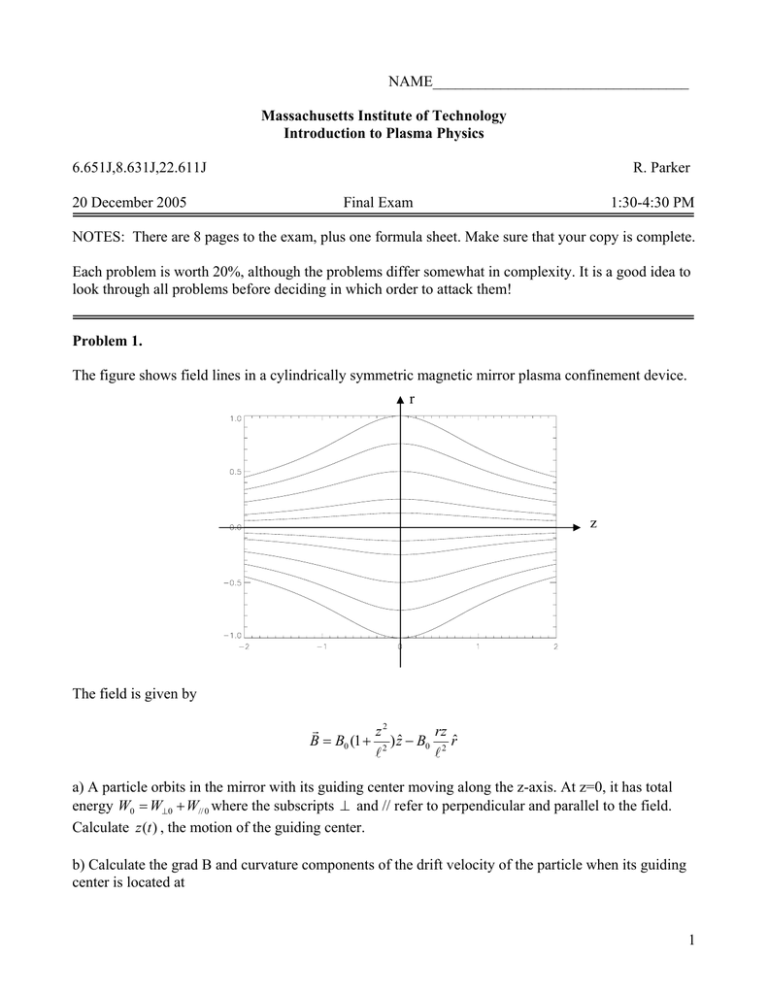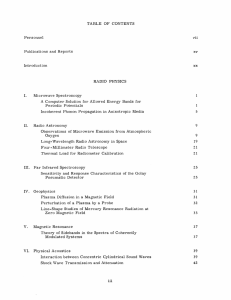NAME__________________________________ 6.651J,8.631J,22.611J 20 December 2005
advertisement

NAME__________________________________ Massachusetts Institute of Technology Introduction to Plasma Physics 6.651J,8.631J,22.611J 20 December 2005 R. Parker Final Exam 1:30-4:30 PM NOTES: There are 8 pages to the exam, plus one formula sheet. Make sure that your copy is complete. Each problem is worth 20%, although the problems differ somewhat in complexity. It is a good idea to look through all problems before deciding in which order to attack them! Problem 1. The figure shows field lines in a cylindrically symmetric magnetic mirror plasma confinement device. r z The field is given by r z2 rz B = B0 (1 + 2 ) zˆ − B0 2 rˆ l l a) A particle orbits in the mirror with its guiding center moving along the z-axis. At z=0, it has total energy W0 = W⊥0 + W// 0 where the subscripts ⊥ and // refer to perpendicular and parallel to the field. Calculate z (t ) , the motion of the guiding center. b) Calculate the grad B and curvature components of the drift velocity of the particle when its guiding center is located at 1 z = 0, r = l / 2 c) Find an equation for z t , the turning point of a particle with a guiding center that passes through the point z = 0, r = l / 2 with energy W0 = W⊥0 + W// 0 . Do not solve the equation. (Hint: this will require calculation of the equation of the field lines.) 2 Problem 2. The ideal MHD equations together with the appropriate form of Maxwell’s equations are: r ∂ρ + ∇ ⋅ ρv = 0 ∂t r dv r r ρ = j × B − ∇p dt d ( pρ − γ ) dt r r r E+v×B =0 r r r ∇ × B = μ0 j , ∇ ⋅ B = 0 r r ∂B ∇× E = − ∂t (1) As we have seen in class, the linearized version of these equations supports undamped shear and compressional Alfvén waves in a homogenous plasma immersed in a uniform magnetic field. For r r example, with B = zˆB0 the E -field in the shear wave can be written r E = xˆE1 cos( k A z − ωt ) where k A = ω / c A and cA is the Alfvén speed. If the conductivity of the plasma is considered to be large but finite, the only modification to the above ideal equations is in the Ohm’s law, which takes the form r r r r E + v × B =η j As expected, the resistivity leads to damping of the Alfvén wave, as you are asked to show in this problem. a) Assume the equilibrium plasma is homogenous, and without current or flow. Specifically assume r ρ = ρ 0 + ρ1 (r , t ) r r r r B = B0 + B1 (r , t ) r r r j = j1 (r , t ) r r r v = v1 (r , t ) r r r E = E1 (r , t ) r p = p0 + p1 (r , t ) where the quantities labeled with a subscript 0 are constants while the quantities labeled with subscript 1 are small perturbations. Write down a complete linearized set of equations for the perturbed quantities. r r b) Assume that we are interested in waves with space-time dependence given by exp(ik ⋅ r − iωt ). In the absence of resistivity, the perturbed magnetic field is given by r r r r k × (v1 × B0 ) B1 = − ω In the presence of resistivity, the perturbed magnetic field can be written in the form 3 r r r r k × (v1 × B0 ) B1 = − ∗ ω Determine ω ∗ . c) Again in the absence of resistivity, the velocity is determined by solution to the equation r [r r r ] rr r ω 2V = c A2 k × (k × (V × zˆ)) × zˆ + cS2 k k ⋅V , where we have taken the equilibrium magnetic field to be in the z-direction. In the presence of resisitivity, the same equation applies, but with c A ⇒ c ∗A and cS ⇒ cS∗ . Determine c ∗A and cS∗ . d) By making the substitution suggested in part c), determine the dispersion relation of the shear r r r Alfvén mode propagating in the direction of B0 with V ⊥ B0 , including the effect of resistivity. e) Assume that ω is real (corresponding to a source of this frequency.) Then, for the wave considered r in part d), k = zˆ (k r + ik i ) , where kr and ki are the real and imaginary parts of the wavenumber. Determine kr and ki. 4 Problem 3. r Consider an axisymmetric θ-pinch in which the plasma rigidly rotates, i.e., V = θˆ r Ω where Ω is a constant. The central beta p0 /( B02 / 2 μ 0 ) is 50%, and the edge speed reaches sonic levels, i.e., aΩ = 2 KT0 , where T0 is the central temperature and a is the plasma radius. Throughout this problem mi assume Te = T i and neglect viscosity. Note: The two parts of this problem are independent. a) Find B(a-), the B-field just inside the edge of the plasma in terms of B0 , the field at the center of the plasma. Assume that the plasma pressure vanishes at r = a. b) The plasma temperature as a function of radius is given by T = T0 (1 − r 2 / a 2 ) 2 while the density is given by n = n0 where n0 is a constant. Determine the confinement time of the plasma defined by τE = W P where W is the thermal energy stored per unit length and P is the power lost by conduction per unit length. Neglect any spatial variation of lnΛ . Express your answer in terms of: a, the plasma radius; τ 0 , a collision time evaluated at r = 0; ρ L , the Larmor radius of a thermal particle also evaluated at r = 0; and B(a-)/B0. Be sure to properly identify the collision time and the Larmor radius in terms of type and species. B A page of possibly useful formulas reproduced from the Plasma Formulary is found on the next page. 5 Problem 4. Consider 1-D plasma oscillations proportional to exp( −iωt + ikx ) in a hot plasma with a 1-D electron distribution function given by ~ v f e (v x ) = e 1 . π v + ve2 2 x For simplicity assume that k is real, but that ω could be complex. a) Determine an algebraic dispersion relation for electron oscillations, assuming that the ions are immobile. b) Solve the dispersion relation obtained in a) for ω (k ). c) Now assume that the ions have a distribution function given by ~ v f i (v x ) = i 1 , π v + vi2 2 x while the electron distribution function is the same as in part a). Assuming ω / k << ve , determine ω (k ) for ion acoustic waves. Possibly useful integrals: ∞ 1 π v ∫−∞ (vx2 +xve2 ) 2 vx − ς dvx = − 2ve ⎧ (ς − ive ) 2 ⎫ ⎨ 2 2 2 ⎬ Im ς > 0 ⎩ (ς + ve ) ⎭ ∞ ⎧ (ς + ive ) 2 ⎫ ⎨ 2 2 2 ⎬ Im ς < 0 ⎩ (ς + ve ) ⎭ 1 π v ∫−∞ (vx2 +xve2 ) 2 vx − ς dvx = − 2ve ∞ ∫ (v −∞ 2 x ⎧ ( v + iς ) ⎫ vx 1 dvx = π ⎨ 2e Im ς > 0 2 2 ⎬ + ve ) vx − ς ⎩ (ve + ς ) ⎭ 2 x ⎧ ( v − iς ) ⎫ vx 1 dvx = π ⎨ 2e Im ς < 0 2 2 ⎬ + ve ) vx − ς ⎩ (ve + ς ) ⎭ ∞ ∫ (v −∞ ∞ 1 π ⎧ (ς − ive ) 2 ⎫ vx2 ∫ (v 2 + ve2 ) 2 vx − ς dvx = − 2ve ς ⎨⎩ (ς 2 + ve2 ) 2 ⎬⎭ Im ς > 0 −∞ x ∞ 1 π ⎧ (ς + ive ) 2 ⎫ vx2 ∫ (v 2 + ve2 ) 2 vx − ς dvx = − 2ve ς ⎨⎩ (ς 2 + ve2 ) 2 ⎬⎭ Im ς < 0 −∞ x 6 Problem 5. A plane wave is incident on a plasma slab, as indicated schematically in the figure below. y ∇n r k x z The plasma density is uniform an the y- and z-directions, but varies in the x-direction and is given by n = n0 x l where l , the gradient scale length, is long compared to the wavelength. i.e., kl >> 1. There is a r magnetic field in the z-direction, B = zˆB0 where B0 is constant. The parameters are such that ω pe ( n = n0 ) = ω ce . Throughout this problem, consider only the electron response to the wave field. 7 a) On the left graph below, indicate the region(s) of propagation up to x / l = 4 for the ordinary mode. b) On the right graph below, indicate the region(s) of propagation up to x / l = 4 for the extraordinary mode. c) What is the maximum depth of propagation of the extraordinary mode for frequencies less than the electron cyclotron frequency? ω/ωce ω/ωce 4 4 3 3 2 2 1 1 1 2 3 4 x/l 1 2 3 4 x/l 8





